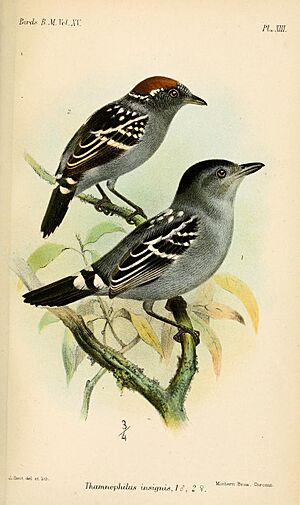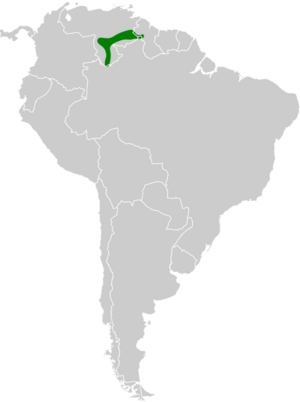Streak-backed antshrike facts for kids
The streak-backed antshrike (Thamnophilus insignis) is a cool bird that lives in the forests of Brazil, Guyana, and Venezuela. It's part of a bird family called "typical antbirds." These birds are known for their strong bills, which are a bit like a shrike's bill.
Quick facts for kids Streak-backed antshrike |
|
|---|---|
 |
|
| Illustration by Joseph Smit, 1890 | |
| Conservation status | |
| Scientific classification | |
| Genus: |
Thamnophilus
|
| Species: |
insignis
|
 |
|
About the Streak-Backed Antshrike
How Scientists Classify This Bird
Scientists group living things into categories. This is called taxonomy. The streak-backed antshrike has two main types, called subspecies. They are T. i. insignis and T. i. nigrifrontalis.
What Does the Antshrike Look Like?
The streak-backed antshrike is about 16 to 17 centimeters (6 to 7 inches) long. It weighs between 22 and 30 grams (about 0.8 to 1 ounce). That's about as much as a few quarters!
Males and females of this bird look a little different. This is called sexual dimorphism.
Male Antshrike Appearance
Adult males of the main subspecies have a black top of the head and back of the neck. They might have a few white feathers there too. Their upper body is black with white spots or streaks. These spots are often seen between their shoulders. Their wings and tail are black with white spots and edges. Their belly is gray, a bit lighter than the rest of their body.
Female Antshrike Appearance
Female antshrikes look a lot like the males. Their forehead might have faint white spots. The back of their head is a dark reddish-brown. Their underparts are usually a bit paler than the male's.
For the T. i. nigrifrontalis subspecies, males look the same as the main type. But the females of this group have a completely black forehead with no spots.
Where the Antshrike Lives
Antshrike's Home and Habitat
The main subspecies of the streak-backed antshrike lives on special flat-topped mountains called tepuis. These mountains are found where southeastern Venezuela, western Guyana, and northern Brazil meet. Most of them are in Venezuela. The other subspecies, T. i. nigrifrontalis, lives on a mountain called Cerro Sipapo in southern Venezuela.
This bird likes to live in humid, evergreen mountain forests. It prefers areas with shorter trees and lots of dense plants underneath. It especially likes places with Melastoma and Clusia plants. You might also find it in thick bamboo patches.
Antshrike's Elevation
The streak-backed antshrike lives at high elevations. It can be found between 900 and 2,000 meters (about 3,000 to 6,500 feet) above sea level. It is more common to see them above 1,200 meters (about 4,000 feet).
Antshrike Behavior
Movement and Migration
The streak-backed antshrike is a resident bird. This means it stays in the same area all year long. It does not migrate to different places.
How the Antshrike Finds Food
Scientists don't know all the details of what the streak-backed antshrike eats. But they know it mainly eats insects and other arthropods (like spiders).
It usually looks for food alone or in pairs. They mostly forage between 1 and 5 meters (3 to 16 feet) off the ground. Sometimes they go as high as 10 meters (33 feet). They hop through the plants, picking prey off leaves, branches, and bamboo. They also grab food from vines. They often reach or lunge from a perch to catch their meal. Sometimes, they join groups of different bird species that are all looking for food together.
Antshrike Reproduction and Life Cycle
Right now, scientists do not know much about how the streak-backed antshrike breeds or raises its young. More research is needed to learn about their nests, eggs, and chicks.
Antshrike Sounds and Calls
Male streak-backed antshrikes sing a special song. It starts slow and gets faster, sounding like a very nasal "cunk, cuk cuk-cu-cu-cu-cu-cu-cu 'cu'cu'cucurank." Females sing a similar song, but their voice is higher pitched.
Their calls include a "raspy growl" that can be different lengths. They also make a soft "squeak" or "peep" sound.
Antshrike Conservation Status
Is the Antshrike in Danger?
The IUCN has looked at the streak-backed antshrike. They have assessed it as "Least Concern." This means it is not currently considered an endangered species.
However, the total number of these birds is not known. Scientists believe their population might be getting smaller. There are no big, immediate threats to the bird.
Threats to Their Habitat
The streak-backed antshrike lives in a somewhat small area. This area includes several protected places. Because the region is hard to reach, humans haven't disturbed the tepui ecosystems much. The plants and animals at higher elevations are still quite natural.
But these special places are very sensitive to changes. There are some threats, like uncontrolled fires and gold-mining activities. It's important to protect these unique habitats for the antshrike and other wildlife.


